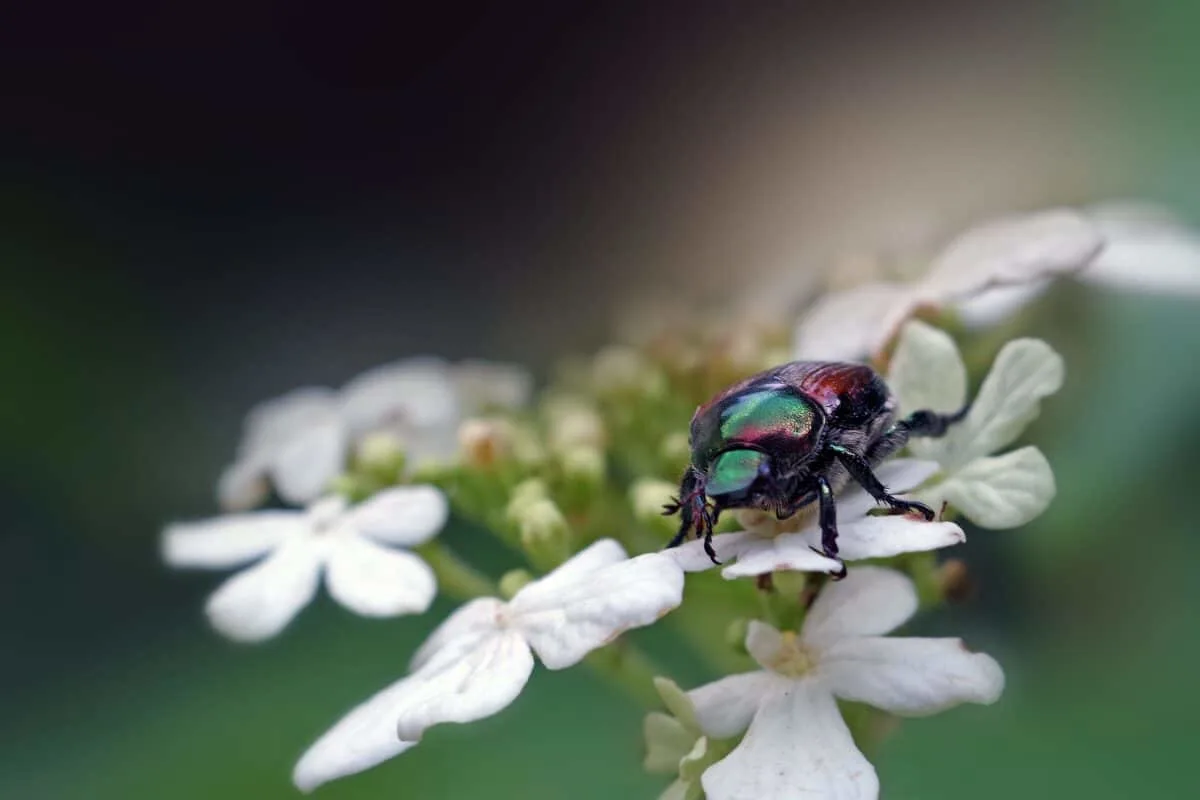Are you an animal enthusiast looking for a unique way to keep pesky Japanese beetles away from your garden? Here’s all you need to know about Japanese Beetle Traps.
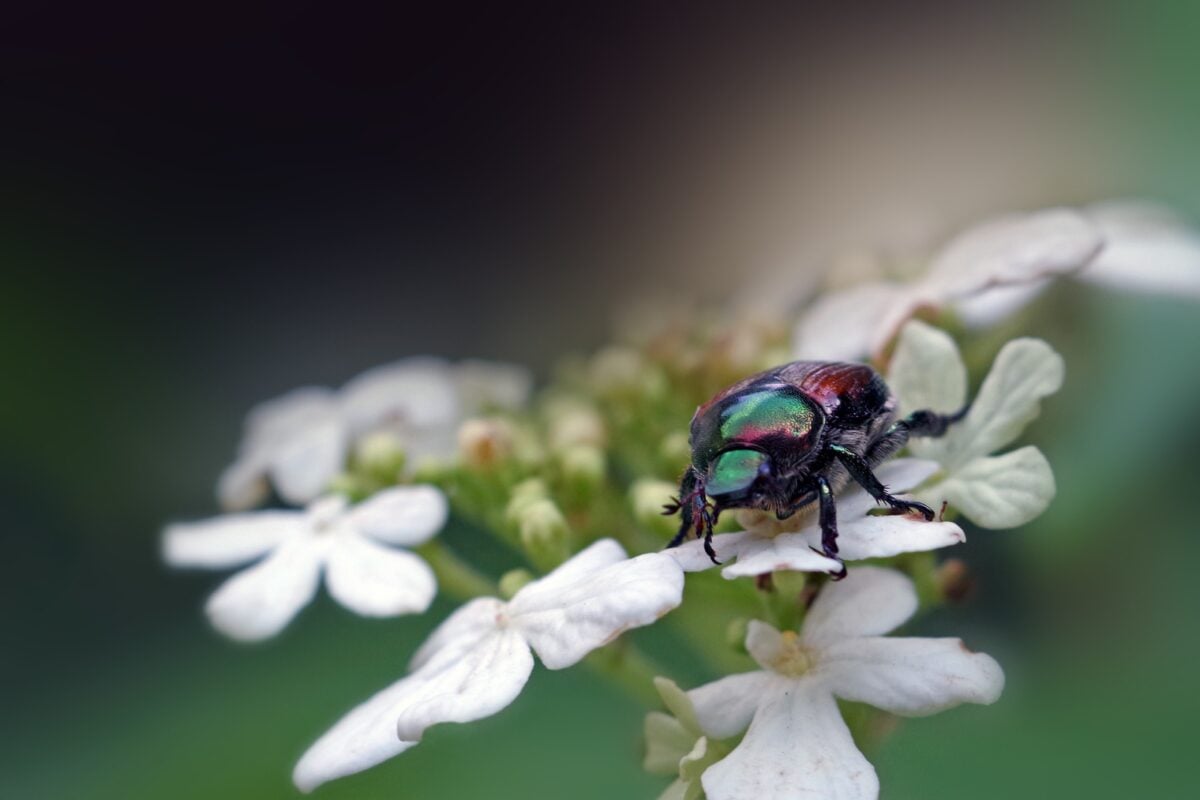
Have you heard of Japanese beetle traps and wondered how effectively they eliminate these unwanted bugs? You may want to consider trying a Japanese beetle trap – a method many animal enthusiasts have found successful.
These traps allow you to efficiently capture and remove large numbers of beetles from your yard. All without resorting to harsh chemical sprays and other pest control solutions! These traps use pheromones to lure in any adult beetles present. This allows you to quickly and easily reduce the number of pests in your yard.
What Are Japanese Beetles?
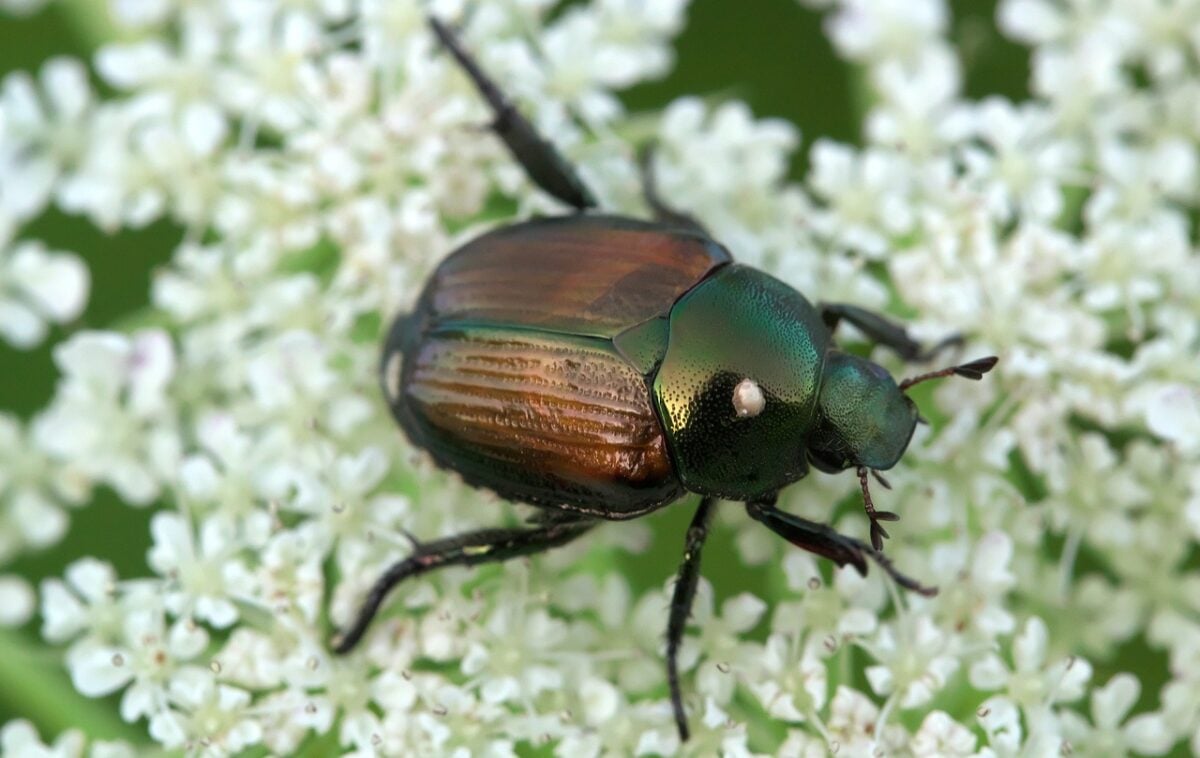
The Japanese beetle originated in Japan but can now be found across much of North America. It earned its name for its striking bronze and green coloration, which is typical for this beetle species.
Despite their beautiful coloring, the Japanese beetle is a significant pest. They do damage to trees, flowers, shrubs, and various garden plants as they feed on the foliage and flowers.
Currently, no known natural predators can keep the populations in check. Much work has been put into developing methods to keep it from damaging gardens in homes and public areas. These range from insecticides to trapping systems, hoping to keep the population manageable.
What Do Japanese Beetles Look Like?
Japanese beetles in North America are the most widely known, with a distinct metallic green color and copper-brown wing covers. These pests measure about 5/16 an inch long and have small white tufts of hair along their sides and bellies.
They can also be identified by their bright scarlet underside and their voracious appetite for plant foliage and flowers. Although gardeners often find clusters of adult beetles feasting on the same plants, this beetle can be scattered over large areas.
With their colorful features and voracious appetite, it’s no wonder that Japanese beetles are among North America’s most recognizable insect pests.
How To Identify a Japanese Beetle Infestation
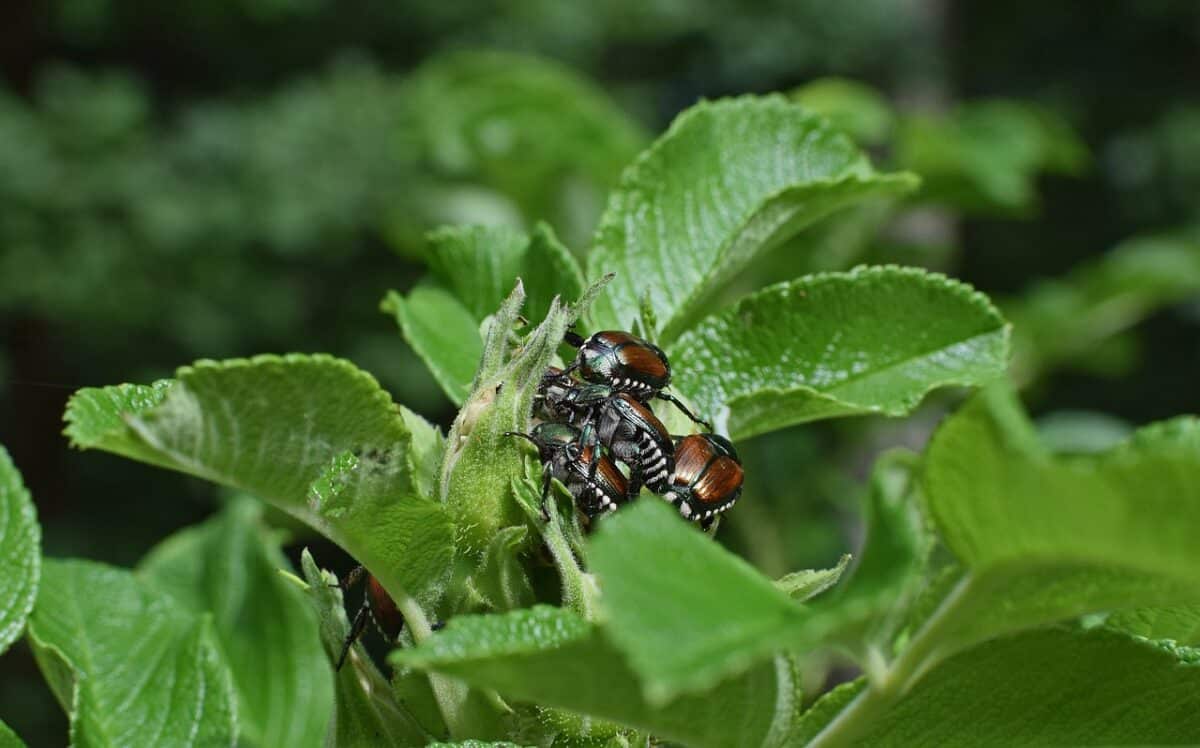
Identifying a Japanese beetle infestation can be tricky. Taking note of the following clues can help you better determine if these insects are present in your garden.
- Japanese beetles have an unusual metallic green or bronze color and grow up to 1/2 inch in length.
- Additionally, they feed on plant leaves, often leaving skeletonized foliage or holes in the leaves.
- Finally, check for clusters of Beetles clinging to the underside of leaves. This is a sign that there are more infesting your plants.
The Damage Japanese Beetles Can Do To Your Plants

Japanese beetles are destructive garden pests that can wreak havoc in your flower beds, vegetable gardens, and turf grass.
They feed on various plants and can quickly defoliate host plants if not appropriately managed. Adult beetles eat foliage directly. Meanwhile larval grubs feed on the roots of many essential types of grass, such as turf grass.
Additionally, these beetles can damage fruit trees and flowers by devouring their leaves. This often results in a reduced yield or crop failure. Once they infest an area, you might notice the characteristic ‘skeletonized’ leaves caused by their feeding habits.
Therefore, it is essential to monitor the presence of Japanese Beetles and take preventative steps so that your garden remains healthy.
Methods of Controlling Japanese Beetles
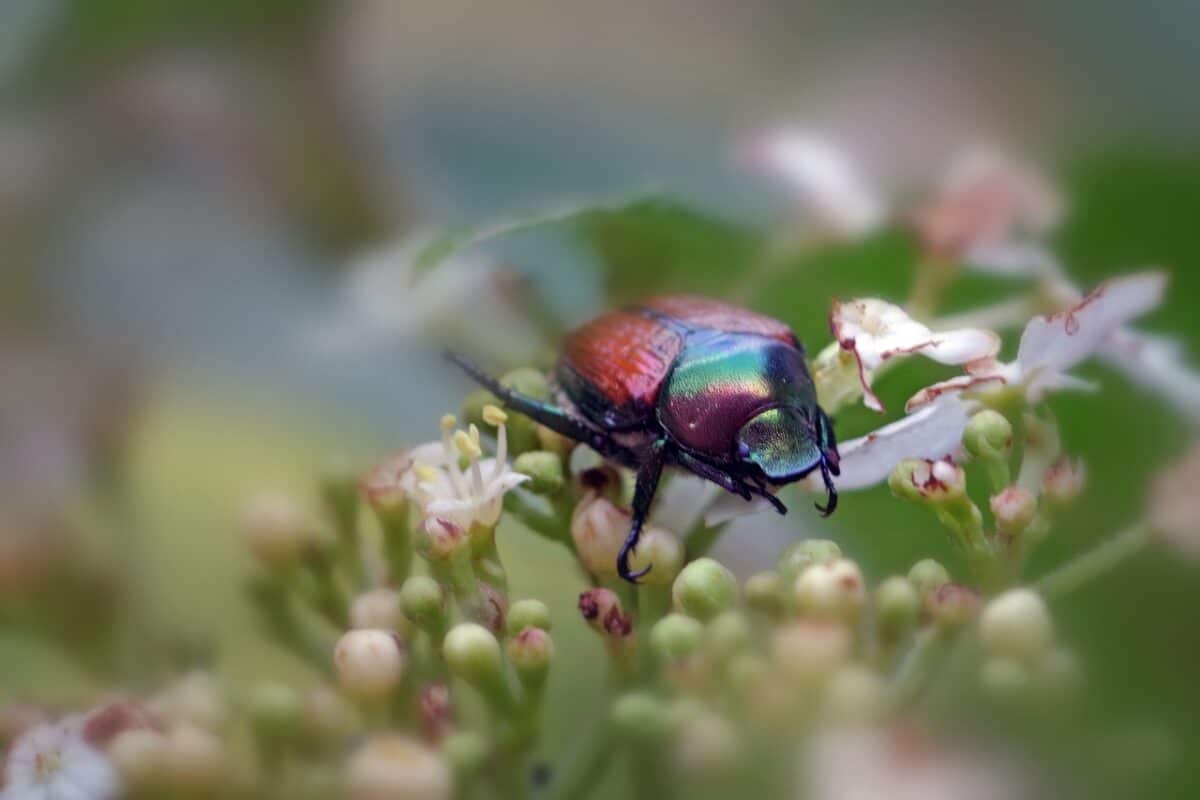
This agricultural pest can cause great concern. Fortunately, there are methods of control that can help gardeners, farmers, and homeowners protect their plants from these destructive insects.
These methods range from chemical control – typically in the form of insecticides – to more natural control measures, such as planting specific plants that are unattractive to the beetles.
Moreover, the physical removal of Japanese beetle adults by hand or using traps can be an effective way to reduce the population on your property. When dealing with this severe pest, make every effort to protect your investment and keep your plants healthy!
Prevention Tips For Japanese Beetle Infestations

They are pesky pests, but preventative measures can go a long way in controlling their population. The first thing is to identify the type of beetle you are dealing with. Secondly; determine the severity of the infestation.
Once you know what kind of beetle it is, you can take several preventative measures. This could include removing larvae from the soil after the adults have died and trimming back nearby vegetation that might attract them. Keeping your yard free from clippings or plant debris will also help keep Japanese beetles at bay.
Furthermore, setting traps or applying insecticides can give additional control over large populations near homes and businesses.
What Are Japanese Beetle Traps?
Japanese beetle traps are effective insect control methods that target larvae, pupae, and adult beetles. They utilize attractive smells to lure in both sexes of the beetle and provide a physical barrier they cannot escape.
Depending on the targeted species, these traps rely on pheromones or floral-type lures to draw beetles in. Although classified as a nuisance for gardeners, these traps offer an easy way to reduce their populations in a way that does not cause harm to the environment or surrounding area. Pesticides are far more destructive and should be used only sparingly when other options have been exhausted.
How Do Japanese Beetle Trap Work
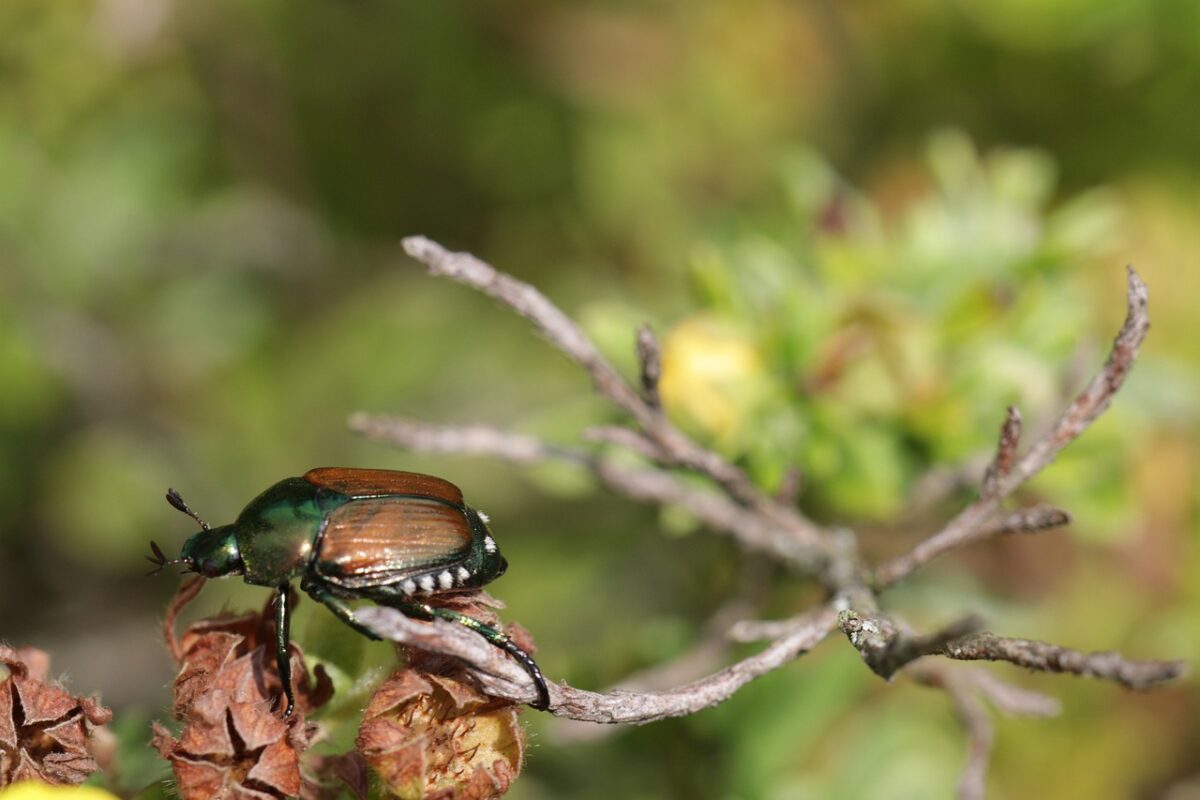
Japanese beetle traps are a common way to deal with the nuisance of this pest. The trap usually consists of a small bag or container securely attached to a stake in the ground. It lures the beetle with a unique scent from flowers, foliage, synthetic lures, and food bait (often made from corn and wheat).
Once the beetle enters the bag, it can’t escape and eventually dies. While commercial and agricultural businesses widely use Japanese beetle traps, they don’t provide 100% protection against beetles. They are typically used alongside other methods of pest control, such as insecticides.
Types of Japanese Beetle Traps
Utilizing Japanese beetle traps is a great way to save your vegetables, flowers, and other plants from the devastation caused by these pesky garden pests. Various types of traps exist to capture Japanese beetles, including:
#1 Bait Traps
Bait traps are a common and practical way of catching small animals without spending much money or time. They use bait, such as food or a powerful scent, to lure the animal into the trap, which then securely locks the animal in and prevents them from escaping. Bait traps use sweet-scented bait to attract adult beetles who will enter the trap and become stuck due to their sticky interior.
These traps give homeowners an easy way to control their pest population without any lasting damage to the animal caught – perfect for those looking for more humane solutions that still get results.
#2 Sticky Traps
Sticky traps are an effective way to get rid of unwanted Japanese beetles. The simple and cost-effective traps use a non-toxic adhesive to capture the insects, thus providing a safe and humane indoor or outdoor insect control solution. No pesticides or toxic materials are used in the traps, and they don’t rely on lures or baits – so no major preventative maintenance is required.
The traps can be positioned around your garden, on trees, fences, patios, and other structures to cover large areas. Furthermore, once the beetles are caught, the sticky substance prevents them from escaping the trap, proving an efficient way of getting rid of nasty bugs!
#3 Pheromone Attractants
Pheromone attractants are an effective way to target pests like the Japanese beetle. By releasing these agents into the environment, Japanese beetles are naturally drawn toward traps that contain a specific pheromone lure scent.
They prove effective and pose minimal risk to humans and other non-target organisms because these attractants are highly specific. Any by-products break down quickly in sunlight or water. With these pheromone attractants, you can create the most effective trap for the Japanese beetle and put safety first.
Using one or all of these traps can help keep populations under control and garden beds free from destruction.
Benefits of Using Japanese Beetle Traps
Japanese beetle traps are an excellent solution for gardens with an influx of Japanese beetles. These traps can be hung from trees and shrubs and use a pheromone attractant to draw the bugs in, trapping them before they can munch on your plants. These traps help save your garden produce from becoming beetle snack food and facilitate the monitoring of beetle population levels in an area.
By paying attention to how full the trap is over time, one can be alerted to detect when Beetle numbers are rising and take steps to fend off an infestation. Ultimately, using these traps helps protect your garden while gaining valuable insight into local beetle populations.
Why you should use Japanese beetle traps:
- The Japanese Beetle Trap is an effective and environmentally friendly way to reduce damage caused by destructive insects. Not only does it help protect valuable trees, shrubs, and flowers, but it also helps minimize the number of harmful pesticides released into the environment. This device uses a special attractant to draw in adult beetles trapped within the device’s container. The trap is easy to assemble and use – hang up the trap from any accessible surface near affected plants or trees.
- The Japanese Beetle Trap offers multiple benefits for homeowners and gardeners alike. It’s non-toxic, odorless, and requires no additional chemical treatments to be effective. You can monitor populations without spraying large amounts of pesticide in your yard or garden, which helps keep your family safe from potentially harmful chemicals. Additionally, this trap type helps reduce stress levels on trees that may otherwise become overwhelmed with adult beetle populations. By trapping them early in the season before they cause significant damage, you can save time and money later on when trying to repair any destruction caused by these pests.
- To protect your plants and trees from damage, the Japanese beetle trap also efficiently reduces egg-laying sites that can lead to future pest infestations. When the traps capture adult females, they cannot reproduce as quickly, which prevents them from spreading further infestations throughout your yard or garden area. Furthermore, because they are attracted to light-colored surfaces like walls and buildings, you can strategically place these traps around your property as a preventative measure against future infestation outbreaks.
Downsides To Using Japanese Beetle Traps
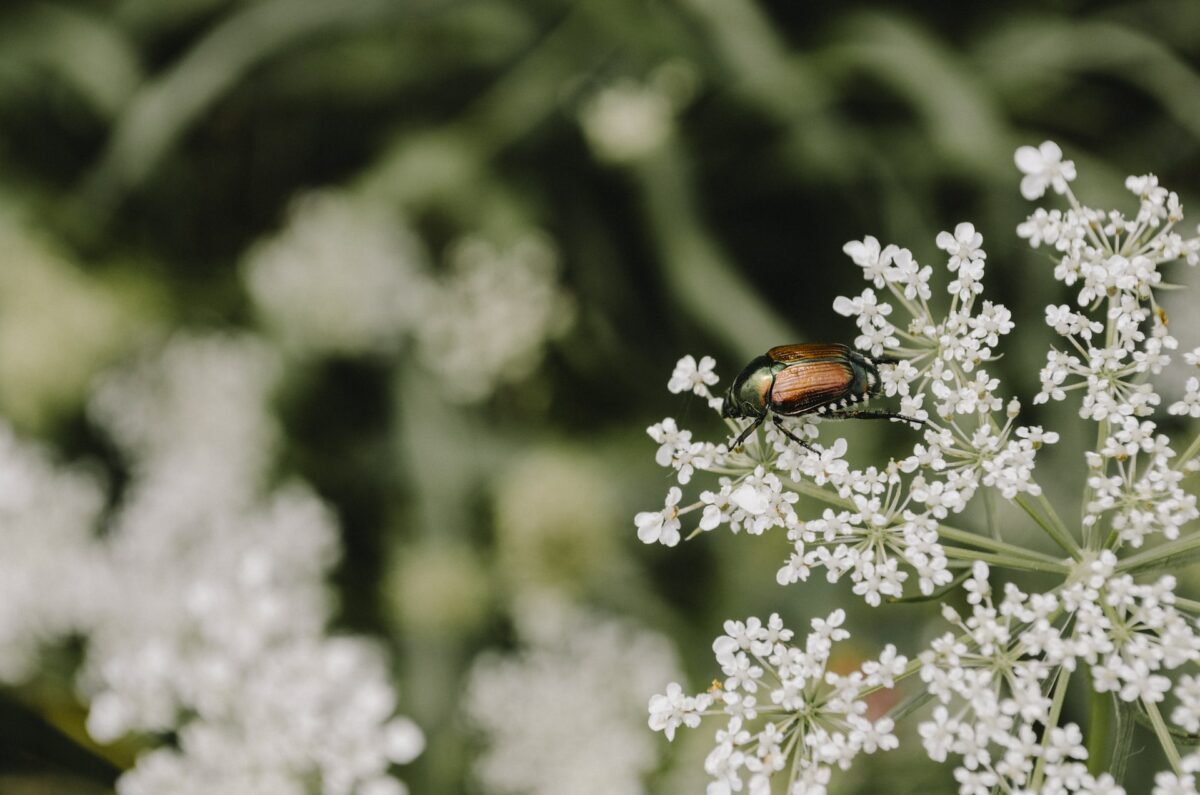
Japanese beetle traps have become increasingly popular as more and more homeowners attempt to rid their lawns of this destructive pest. But while these traps are undoubtedly effective, they have a few potential downsides that should be considered before using them.
- Firstly, the pheromone used to attract the beetles can also draw in other insects besides Japanese ones. It increases the pests you’ll need to deal with, potentially leading to an even more significant infestation in your garden or lawn.
- Secondly, Japanese beetle traps provide a food source for local birds and animals, luring them into your yard and encouraging them to dine on vegetables or flowers.
- Finally, research has shown that vast numbers of these traps placed close together can work against one another by producing too many chemical odors, thus diminishing their effectiveness at trapping the beetles altogether.
How To Choose The Right Japanese Beetle Trap For Your Needs
Choosing the right Japanese beetle trap is essential in protecting your garden from these destructive pests. There are numerous ways when deciding on the best trap for your needs.
Consider the size of the area you want to protect and how many traps you need. It will help determine the size and type of traps you purchase.
Next, consider the bait or lure you want to use in your trap as fruit-based scents like overripe apples or bananas and floral scents like roses and geraniums. Different types of lures have different levels of effectiveness, so it’s essential to research before purchasing one for your needs.
Finally, you’ll need to decide if you want a disposable or reusable trap. Disposable traps are designed for single use only, while reusable traps can be emptied and reused multiple times with a fresh batch of bait or lure each time.
While reusable traps are more expensive upfront than disposable ones, they may save money in the long run since they don’t need to be replaced every few weeks or months as their disposable counterparts do. Additionally, because they are reusable, they tend to last longer too, which means they can protect against Japanese beetles year after year.
No matter what type of Japanese beetle trap you choose, proper placement is vital for successful control measures. Place your traps some distance away from other plants in your garden so that any attracted beetles won’t spread diseases or damage crops while feeding on them.
Where To Buy Japanese Beetle Traps
Finding the right Japanese Beetle trap can be tricky: they come in many sizes and shapes! Use a trusted vendor that offers proven and effective traps. Make sure to read product reviews before you purchase – you want one that is reliable and works well to control your beetle population.
Do some online research and find the best Japanese beetle trap for your particular needs.
Finally, if you aren’t comfortable buying online, it may be worth checking out local garden stores for options too!
Conclusion

| Key Points |
| Japanese beetles in North America are the most widely known beetles, which have a distinct metallic green color and copper-brown wing covers and grow up to 1/2 inch in length. |
| The Japanese beetle traps allow you to efficiently capture and remove large numbers of beetles from your yard without resorting to harsh chemical sprays and other pest control solutions. |
| These traps can be hung from trees and shrubs and use a pheromone attractant to draw the bugs in, trapping them before they can munch on your plants. |
| Various traps capture Japanese beetles, including bait traps, sticky traps, and pheromones attractants. |
| Japanese beetles are destructive garden pests that can wreak havoc in your flower beds, vegetable gardens, and turf grass. |
Japanese beetle traps can be a helpful tool in your fight against these pests, but it’s essential to understand the science behind their use and best practices for placement and maintenance before setting them up in your yard. These traps can effectively reduce the population of these unwanted pests in your garden, but it’s essential to use them correctly.
Place your traps in strategic locations around your property, avoiding creating exclusion zones that could attract more beetles to your yard. Additionally, be sure to empty and clean your traps regularly so that they remain effective.
With that knowledge in mind, you can decide if Japanese beetle traps are the right solution for keeping these unwanted critters away from your garden.
Thank you for reading this article! Insects have a tendency to annoy us, and some more than others; read our post about No-See-Ums to learn how to prevent them from ruining your next trip to the great outdoors.
Join our Forum for free today!


